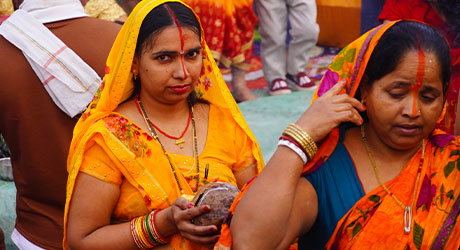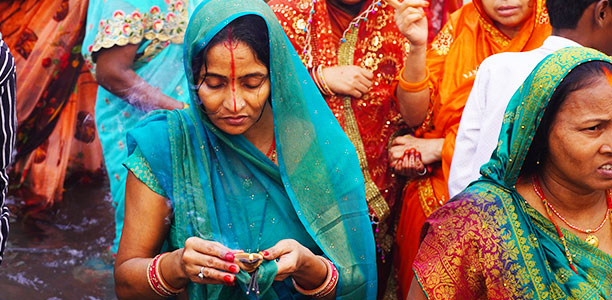As the crisp autumn air sweeps across the Indian subcontinent, communities prepare for the vibrant and sacred festival of Chhath Puja. This ancient Hindu festival, dedicated to the Sun God, Surya, and his consort Usha, holds immense cultural and spiritual significance. Chhath Puja is a four-day celebration that involves rigorous rituals, fervent prayers, and a deep connection with nature. In 2023, the festival promises to unite communities in a celebration of gratitude, faith, and devotion.
Chhath Puja is a unique and elaborate festival celebrated primarily in the Indian states of Bihar, Jharkhand, Uttar Pradesh, and in some parts of Nepal. The festival involves a series of rituals and observances over a span of four days, dedicated to the worship of the Sun God, Surya, and his consort Usha. Here’s a brief overview of how Chhath Puja is traditionally celebrated:

Day 1: Nahay Khay (Bathing and Eating)
The festival begins with devotees, mainly women, taking a dip in a sacred river, pond, or other water bodies. This ritual is believed to purify the mind, body, and soul. After the holy bath, devotees prepare a special meal, typically consisting of rice and gourd (pumpkin), known as “kaddu-bhat.” This marks the commencement of the Chhath Puja festivities.
Day 2: Kharna (Fast and Preparing Offerings)
On the second day, devotees observe a day-long fast, breaking it only in the evening after sunset. The fast is broken with a special kheer (sweet rice pudding) and chapatis, which are offered to the deities and then distributed among family members. The rituals on this day are dedicated to ensuring the well-being and prosperity of the family.
Day 3: Sandhya Arghya (Evening Offerings)
The third day is the most significant and is known as Sandhya Arghya. Devotees, mostly women, gather at the ghats (riverbanks) or other water bodies to make offerings to the setting sun. The offerings, including thekua (sweet wheat-based cookies), fruits, and sugarcane, are arranged on trays made of bamboo and sugarcane. The rhythmic chanting of Vedic hymns accompanies the rituals, expressing gratitude for the life-sustaining energy of the sun.
Day 4: Usha Arghya (Morning Offerings)
The final day, Usha Arghya, involves offering prayers to the rising sun. Devotees wake up before dawn to prepare offerings and perform rituals as the first rays of the sun illuminate the surroundings. This symbolic act signifies the victory of good over evil and light over darkness. The entire atmosphere is charged with spirituality and devotion.

Community Participation:
Chhath Puja is not just a family affair; it is a community celebration. Families, friends, and neighbours come together to support each other in observing the rituals. The collective spirit during Chhath Puja fosters a sense of unity and brotherhood among the community members.
Environmental Aspect
One notable feature of Chhath Puja is its minimal impact on the environment. The rituals are performed without elaborate decorations or the use of artificial materials, emphasizing a connection with nature and promoting environmental sustainability.
To summarize, Chhath Puja is a deeply spiritual and community-centric festival that involves rigorous rituals, fasting, and offerings to express gratitude to the Sun God for the sustenance of life on Earth. The festival is a beautiful blend of tradition, devotion, and environmental consciousness.

